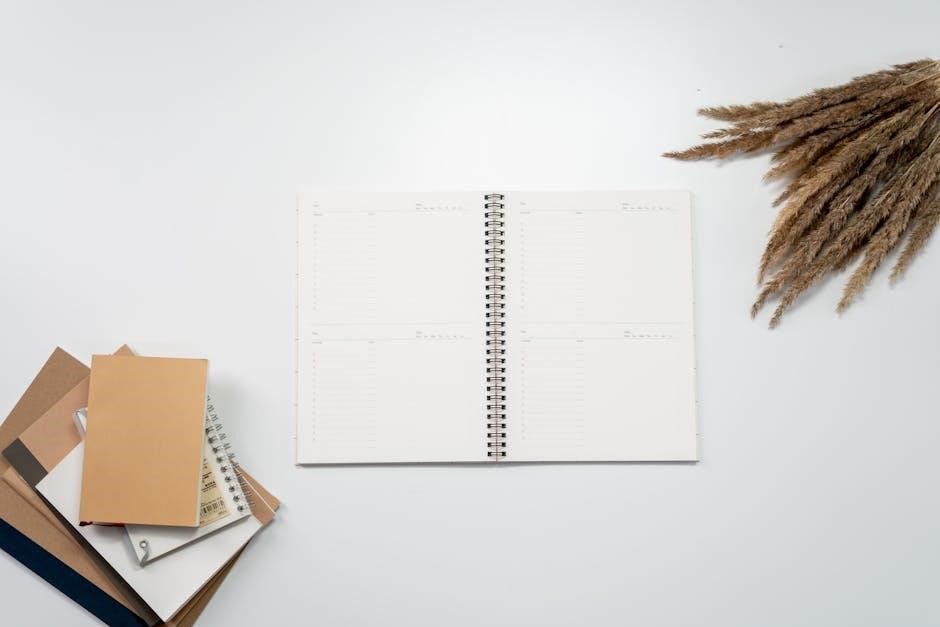A Zone 8b planting schedule is a tailored guide for gardeners in USDA Hardiness Zone 8b, offering optimal planting times for vegetables, fruits, and flowers to thrive in the region’s mild winters and hot summers.
Understanding USDA Hardiness Zones and Their Importance
USDA Hardiness Zones are regional maps dividing the U.S. into areas based on average annual extreme temperatures. Zone 8b, with mild winters and hot summers, has an average last frost date in mid-March and first frost in early November. These zones guide gardeners in selecting plants suited to their climate, ensuring optimal growth and productivity. Understanding your zone is crucial for timing plantings correctly and maximizing garden success throughout the year.
Why a Planting Schedule is Essential for Zone 8b Gardeners

A planting schedule is vital for Zone 8b gardeners to maximize their growing season. It ensures plants are started at the right time, avoiding frost damage and heat stress. By following a schedule, gardeners can optimize soil preparation, succession planting, and crop rotation. This organized approach helps gardeners make the most of Zone 8b’s long growing season, ensuring healthy plant growth and higher yields throughout the year.

Frost Dates and Their Impact on Planting
Frost dates are critical for determining planting times, ensuring plants avoid damage from early or late frosts, and maximizing the growing season’s potential in Zone 8b.
Average Last Frost Date in Zone 8b
The average last frost date in Zone 8b typically falls around mid-March, marking the end of winter and the start of the growing season. This date is crucial for gardeners, as it determines when to safely plant warm-season crops outdoors. Knowing this date helps avoid frost damage to tender plants and ensures optimal growth. Gardeners in Zone 8b can begin transplanting seedlings like tomatoes and peppers after this date, taking advantage of the region’s long growing season.
Average First Frost Date in Zone 8b
The average first frost date in Zone 8b usually occurs around early November, signaling the end of the growing season. This date is vital for planning fall plantings, as it determines when to harvest cool-season crops before frost sets in. Gardeners in Zone 8b should prepare for frost protection measures, such as covering sensitive plants or bringing them indoors, to protect their crops from potential damage during this period.
How to Use Frost Dates to Plan Your Garden
Understanding frost dates is crucial for planning a thriving garden in Zone 8b. Calculate planting times by counting backward from the average first frost date for fall crops and forward from the last frost date for spring plantings. Start seeds indoors 4-6 weeks before the last frost date and transplant after the soil warms. For fall, sow cool-season crops 8-10 weeks before the first frost to ensure maturity. Use frost dates to time harvests and prepare frost protection for sensitive plants.
Spring Planting in Zone 8b
Zone 8b’s mild winters and warm springs make it ideal for early planting. Start with cool-season crops like spinach and lettuce, then transition to tomatoes, peppers, and zucchini as temperatures rise.
Best Vegetables to Plant in Early Spring
In Zone 8b, early spring is perfect for planting cool-season crops like spinach, broccoli, and carrots. These vegetables thrive in cooler temperatures before summer heat sets in. Leafy greens such as kale and arugula also excel, providing fresh harvests. Plant these 4-6 weeks before the last frost date to ensure maturity. Beets and radishes are additional excellent choices, as they grow quickly and tolerate light frosts. Starting these vegetables early maximizes the growing season and ensures a bountiful spring harvest.
Optimal Time for Transplanting Seedlings Outdoors
In Zone 8b, the best time to transplant seedlings outdoors is after the last frost date, typically around late March to early April. This ensures tender plants like tomatoes and peppers avoid frost damage. Harden off seedlings by gradually exposing them to outdoor conditions over 7-10 days. Choose a cloudy or cooler day for transplanting to reduce stress. Soil should be warm, and weather stable, to promote healthy root growth and maximize the growing season.
Summer Planting in Zone 8b
Zone 8b’s warm summers are ideal for growing heat-tolerant crops like tomatoes, peppers, and zucchini. Ensure plants receive full sun and consistent moisture for optimal growth.
Heat-Tolerant Crops for Zone 8b Summers
Zone 8b’s hot summers are perfect for growing heat-tolerant crops like tomatoes, peppers, zucchini, and okra. These plants thrive in full sun and warm temperatures, requiring consistent moisture. Southern peas and eggplant also excel in Zone 8b’s climate. Plant these crops after the last frost date to ensure optimal growth. Proper watering and mulching can help protect them from extreme heat, ensuring a bountiful harvest throughout the summer season.
Managing Soil Health During Hot Months
Maintaining soil health in Zone 8b’s hot summers is crucial for plant survival. Mulch helps retain moisture and suppress weeds, while compost enriches the soil with essential nutrients. Avoid over-tilling, as it can damage soil structure. Regularly test soil pH and nutrient levels to ensure optimal conditions. Drought-resistant ground covers can protect the soil from extreme heat. Proper irrigation and organic amendments will keep your soil fertile and support healthy plant growth throughout the summer season.

Fall Planting in Zone 8b
Fall planting in Zone 8b offers a second growing season, ideal for cool-season crops like leafy greens and Brassicas. The mild autumn weather promotes healthy growth, ensuring a bountiful harvest before winter.
Leafy Greens and Cool-Season Crops for Fall
Fall in Zone 8b is perfect for planting leafy greens like kale, spinach, and Swiss chard, which thrive in cooler temperatures. Cool-season crops such as broccoli, cauliflower, and Brussels sprouts also excel, maturing before the first frost. These crops prefer well-prepared soil and consistent moisture, making them ideal for a productive fall garden. Planting them in late summer to early fall ensures a robust harvest during the cooler months.
Preparing the Soil for Fall Planting
Preparing the soil for fall planting in Zone 8b involves amending it with compost or well-rotted manure to improve fertility and drainage. Test your soil pH and adjust if necessary, as most fall crops prefer a slightly acidic to neutral soil pH. Loosen the soil to a depth of 8-10 inches to promote root growth. Avoid over-tilling, as it can damage soil structure. Incorporate organic matter evenly to create a balanced growing medium for cool-season crops like spinach, kale, and broccoli.
Winter Planting in Zone 8b
Zone 8b’s mild winters allow gardeners to grow hardy vegetables like kale, spinach, and broccoli. The cooler months offer ideal conditions for these crops to thrive.
Hardy Vegetables That Thrive in Mild Winters
In Zone 8b, hardy vegetables like kale, collards, spinach, and broccoli excel during the mild winters. Root vegetables such as carrots and radishes also perform well. These plants are adaptable to cooler temperatures and can tolerate light frosts, making them ideal for fall and early winter planting. Proper soil preparation and timing ensure robust growth. Planting these crops in late summer or early fall allows them to mature before the first frost, providing a bountiful harvest during the cooler months.
Protecting Plants from Frost Damage
Protecting plants from frost damage is crucial in Zone 8b, even with its mild winters. Use covers like sheets or blankets to shield plants from frost, and bring potted plants indoors during cold snaps. Mulching helps retain soil warmth, while watering plants before frost can provide additional protection. These methods ensure your plants survive and thrive despite occasional frost events.

Using a Zone 8b Planting Schedule PDF
A Zone 8b Planting Schedule PDF offers a comprehensive guide for gardeners, providing organized charts and timelines to maximize planting success throughout the year.
How to Download and Use the PDF Guide
To download the Zone 8b Planting Schedule PDF, visit trusted gardening websites or resources that offer detailed planting charts tailored to your zone. Once downloaded, review the guide for specific planting timelines, frost dates, and crop recommendations. Use the charts to plan seed sowing, transplanting, and harvesting. Pay attention to key features like optimal planting times for vegetables, fruits, and flowers, ensuring you maximize your garden’s productivity year-round.
Key Features of a Comprehensive Planting Schedule
A comprehensive Zone 8b planting schedule PDF includes detailed charts for vegetables, fruits, and flowers, specifying sowing and harvesting times. It highlights frost dates, optimal transplanting periods, and variety recommendations. The guide also covers soil preparation tips and succession planting strategies. These features ensure gardeners can plan effectively, maximize yields, and adapt to seasonal changes, making it an indispensable tool for achieving gardening success in Zone 8b.
Using a Zone 8b planting schedule PDF ensures a thriving garden by guiding plant choices and timing. Monitor frost dates and adjust planting accordingly for optimal results. Happy gardening!
Maximizing Your Garden’s Potential in Zone 8b
Zone 8b offers a long growing season, ideal for diverse crops. By understanding frost dates and soil preparation, gardeners can optimize plant selection and timing. Focus on heat-tolerant vegetables like tomatoes and peppers in summer, and cool-season crops such as kale and spinach in fall. Incorporate compost and efficient watering practices to maintain soil health. Using a Zone 8b planting schedule ensures a balanced and productive garden year-round, making the most of the region’s unique climate.
Common Mistakes to Avoid in Zone 8b Gardening
Common mistakes in Zone 8b gardening include overwatering, which can lead to root rot, and ignoring frost dates, risking crop damage. Many gardeners also fail to prepare soil properly, missing out on optimal nutrient levels. Planting too early or late without consulting a schedule can reduce yields. Additionally, neglecting companion planting and improper watering techniques can harm plant health. Avoiding these errors ensures a thriving and productive garden tailored to Zone 8b’s unique conditions.